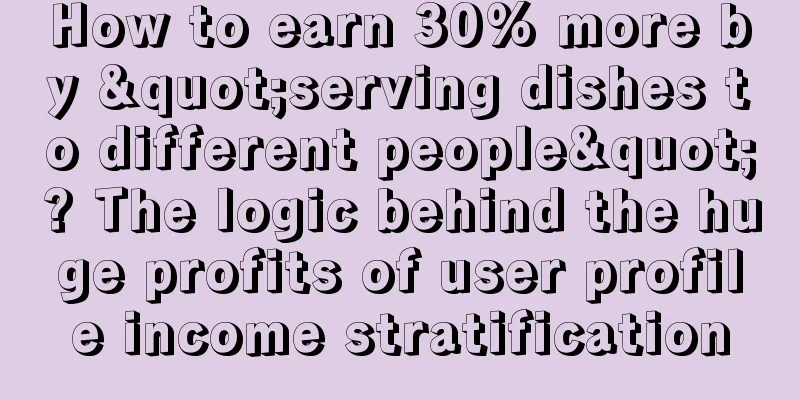How to earn 30% more by "serving dishes to different people"? The logic behind the huge profits of user profile income stratification

The ultimate secret of e-commerce is not how cheap the goods are, but “ being able to tell who is rich at a glance ”! 1. Why do e-commerce companies “order dishes based on revenue”?The logic of profiteering from tiered operations 1) Earn “experience fees” from the rich and “traffic fees” from the poor High-income users: willing to pay 50% more for “saving time, exclusive products, and exclusive services” (data from a luxury e-commerce company); Low-income users: rely on low-priced hot-selling products to boost sales and use scale to spread costs (the GMV of Pinduoduo's 9.9 free shipping accounts for more than 60%). 2) Avoid “accidental losses” Negative example: A platform pushed Dyson hair dryers to young people in small towns, but the ROI was only 0.3, resulting in a loss of millions. Positive case: JD PLUS members’ exclusive discounts increased the repurchase rate of high-income users by 70%. 3) Increase customer lifetime value (LTV) High-income users: average annual consumption of 80,000, LTV is 10 times that of ordinary users; Low-income users: attract traffic through the "9.9 trial" and increase profits through subsequent cross-selling. 2. Case Study: Income StratificationHow to let giants “count money while lying down”? Case 1: The “address metaphysics” of express delivery companies Parse the user's delivery address → match the housing price of the residential area (e.g. Beijing Wanliu Academy = 150,000/㎡); For users with high-frequency and high-end addresses, the "insurance + scheduled delivery" service will be automatically upgraded; Result: The average order value of high-end users increased by 120%, and after-sales costs decreased by 30%! Case 2: Pinduoduo’s “salary slip harvesting technique” Reversely estimate revenue using "delivery address province + shopping cart low-priced goods ratio": Third- and fourth-tier cities + group-buying ratio > 80% → marked as "price-sensitive users"; Targeted push of "price cuts" and "10 billion subsidies" contributed more than 50% to GMV. Case 3: The “rich lady circle” strategy of a maternal and infant e-commerce company Filter users who have "bought imported milk powder + received it in a villa area in a first-tier city"; push high-end early childhood education classes priced at 4,999 yuan per class, with a conversion rate of up to 15%; Profit: Marginal cost is almost 0 and gross profit margin exceeds 80%. III. Practice: 5 big data sources to accurately understand user income1. Address information: the most hardcore "wealth code"Access the real estate platform API (such as Lianjia) to map the address to the average price of the community; Example of rule: House price>100,000/㎡ → Ultra-high net worth users; House price < 20,000/㎡ → Subsidize sensitive users. 2. Consumption behavior: “class signals” in shopping cartsBrand contempt chain: users who buy LV vs. users who buy Nanjiren; Decision-making speed: More than 60% of high-income users place orders within 3 hours after adding items to cart. 3. Payment habits: Your payment method betrays youCharacteristics of the rich: full payment by credit card, frequent use of Apple Pay; Characteristics of workers: the proportion of installment payment and pay-later payment is > 50%. 4. Devices and apps: The model of your phone is your “pay slip”80% of Huawei Mate 60 RS users have a monthly income of more than 30,000 yuan; 60% of Redmi Note users have a monthly income of less than 8,000 yuan. 5. External data “traceless skinning”China Unicom operator data: 199 yuan package users vs 29 yuan package users; WeChat friend list: Friends who sell luxury goods → potential high net worth users. IV. Revenue Label and Differentiated Operation StrategyExample of rule: If the average price of the community is > 100,000 and has purchased luxury goods: Tagged as "Ultra High Net Worth" elif 5 orders are placed per month and the average order value is less than RMB 50: Marked as "price sensitive" High-income users: Pushing the “Personal Shopping Guide” service increased the conversion rate by 30%; Pre-sale codes for scarce products will be distributed on membership day (hunger marketing). Low-income users: Pushing "limited time flash sales" at 8 pm has a conversion rate 3 times higher than during the day; Use the "10 yuan return for orders over 3" hook to increase repeat purchases. 5. NotesPrivacy compliance: Never ask about salary directly! Use "housing price range in the neighborhood" instead of specific address. “Static label” trap: Workers may change jobs to get a salary increase, and need to update data every month (for example, the delivery address changes from a village in the city to the CBD). Regional differences: In Shenyang, a monthly income of 10,000 is considered rich, while in Shanghai a monthly income of 30,000 is considered passing. The difference must be calibrated by city! ConclusionIn the world of e-commerce, the thickness of users’ wallets has never been a secret, but rather a calculable and manipulable data game. |
>>: AI influencer, working 24 hours a day, earning 70 million yuan a year
Recommend
0 budget, the way to rejuvenate the brand has changed again!
Has the way contemporary brands are playing with y...
Affordable ice cream is back, but summer is long over
The live broadcast ecosystem has taken on a new lo...
What is the Weee certification registration process? Process Introduction
When doing cross-border business abroad, if electr...
How to increase the popularity rate of business reporting notes on Xiaohongshu?
Is there a so-called template for popular articles...
What do people want to see when they look at treasure appraisal?
Are you paying attention to the recently popular &...
How can crowd brands increase their business?
This article focuses on crowd brands and analyzes ...
Cross-border e-commerce in Southeast Asia is heating up
As global trade continues to deepen, the cross-bor...
How does a brand grow?
The elements of brand success are the result of th...
When can I get commission if I join Amazon on the 15th? How much is the salary?
Some friends are planning to work in cross-border ...
Do I need to clear customs duties when opening a store on eBay? Will I be taxed?
When Eachnet was officially listed in China, there...
Can Amazon change the price during its 7-day flash sale? How long does it take to register a flash sale for a new product on Amazon?
As one of the world's largest online shopping ...
How is ocean freight calculated? What are the cross-border e-commerce logistics models?
If merchants want to open a store on a cross-borde...
Kuaishou will no longer provide financial support to Station A by not renewing the contract with the UP host
Station A, as a control group of Station B, is now...
How to upload products to Amazon store? What are the uploading steps?
After opening an Amazon store, merchants need to u...
After e-commerce platforms move closer to user needs, can they win back more users’ minds?
Previously, Taobao, JD.com, Kuaishou, Douyin and o...









